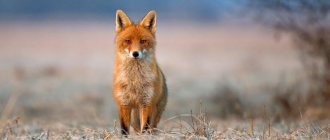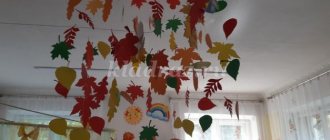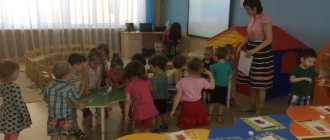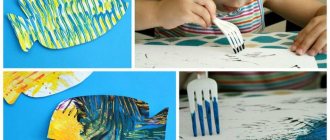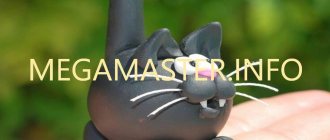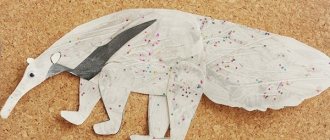Card index of cognitive and research activities (first junior group)
Theme: “I bake, bake, bake...”
Materials: sand molds, wet sand, cloth napkins.
Progress of the experiment:
Let's try to mold various figures from wet sand using molds. Leave until dry.
— What happens to sand crafts after drying?
Conclusion: You can sculpt from wet sand, but after drying it crumbles.
Topic: “Traces and imprints remain on wet sand”
Objectives: expand children’s understanding of the properties of wet and dry sand.
Material: trays with wet and dry sand.
Procedure of the experiment: Suggest leaving handprints on dry sand. Are the prints clearly visible? (no) The teacher wets the sand, mixes it, levels it, and offers to leave handprints on the wet sand. Is it working now? (Look, every finger is visible)
Conclusion: There are traces and imprints on wet sand, but not on dry sand.
Theme: “Does sand fall easily” (walk)
Objectives: expand knowledge about the properties of dry sand.
Material: trays with sand.
Procedure of the experiment: Suggest that you take a handful of sand into your fist and release it in a small stream. — Does it crumble easily?
Conclusion: dry sand easily crumbles and crumbles into grains of sand.
Topic: “Why is it inconvenient to play with sand in strong winds” (walk)
Material: “sandbox” - a jar with a thin layer of sand poured into it.
Progress of the experiment: Examination of the prepared “sandbox”. We create a “hurricane” - we sharply squeeze the can with force. - What is happening and why?
Conclusion: The grains of sand are small, light, do not stick to each other, they cannot hold on to each other or to the ground with a strong stream of air.
Theme: “Wet sand takes any desired shape” (walk)
Material: sandbox with wet sand, various molds. Scoops for sand.
Progress of the experiment:
Pour wet sand into molds and make figures. - What kind of figures did you get? — What kind of sand were you able to make the figures from?
Conclusion: Wet sand takes any shape.
Theme “Where did the water disappear” (walk)
Objectives: show children that when water gets on sand, it is quickly absorbed.
Material: cups with sand and water.
Procedure of the experiment: Pour water into a glass of sand. Let's touch the sand. -What did he become? -Where did the water go?
Conclusion: water is quickly absorbed into the sand.
Theme "Soap bubbles"
Goal: to create a desire to blow soap bubbles, to introduce the fact that when air gets into soapy water, a bubble forms.
Material: soapy water, cocktail straws, helium pen body.
Progress of the experiment:
Lather your hands until you get a lush, thick foam. Then separate your palms so that a thin transparent soap film forms between them. Blow on it and you will get a soap bubble. To encourage your child to blow soap bubbles on his own, offer him, in addition to the frame from the purchased bubble, a variety of straws - a cocktail straw. To get a solid straw (kids often bite or bend cocktail straws), you can disassemble the helium pen and take the body from it. You can make your own bubble water using dishwashing liquid.
Experimental game “Which will last longer?” (walk)
Objectives: Show children that air is easy to detect if you create its movement.
Material: Feather, tree leaf, sheet of paper.
Procedure of the experiment: Invite two children to simultaneously blow a feather and a leaf from a tree from their palms. - Why did a feather and a leaf fly in the air? (we blew on him) - What doesn’t fall longer? (a feather, it’s lighter).
Theme: “Blowing soap bubbles” (walk)
Objectives: consolidation of knowledge about air, raising the emotional mood.
Material: Soapy water, cocktail straws, bottles with the bottom cut off, helium pen body.
Procedure: Offer children cocktail straws, bottles with the bottom cut off, the body of a helium pen, and soapy water. During the game, create a friendly attitude towards each other.
Topic: “Why the boats don’t sail”
Objectives: detect air, create wind.
Material: paper and foam boats, bath with water.
Progress of the experimental game: Invite the children to lower the boats into a bath of water, ask if the boats float, why? What needs to be done to make the boats sail? Listen to the children’s suggestions and bring them to the conclusion that wind is needed. Where to “get” the wind? Children blow on boats and create wind.
Topic "What's in the bag?" Experiment (walk)
Goal: Teaching children how to show.
Objectives: Teach children to perform actions as shown by the teacher. Create a feeling of joy and interest.
Procedure: We fill a plastic bag with air and close it. When we open the bag, the air comes out and the bag is empty.
Experimental game “Who will have the longest feather without falling?” (walk)
Objectives: raising the emotional mood, consolidating knowledge about the air.
Material: Bird feathers.
Procedure of the experiment: Together with the children, place a feather on your palm (the feather flew away). Explain to children that air is easy to detect if you create its movement (i.e. when we blow on a feather).
Theme "Pebbles"
Objectives: to form children’s ideas about the properties of stones: heavy, strong, hard; at the request of an adult, choose stones by size, color, smoothness, etc.
Materials: Foam sponges, stones of different sizes, colors, smoothness.
Procedure of the experiment: Invite children to press on a sponge, a stone (the sponge is pressed, the stone is not), try with the children to squeeze the stone, the sponge (the stone does not compress, the sponge does), determine the weight in the palm of your hand, the stone is heavy. Invite children to choose stones of different colors, shapes, and surfaces.
Conclusion: the stone is hard, strong, heavy. It comes in different colors, shapes, surfaces (smooth, rough).
D/i “Find identical pebbles by size, color, smoothness” (walk)
Tasks: we continue to consolidate the properties of stones.
Material: pebbles of different shapes, smoothness, and sizes.
How to play: Invite children to find identical pebbles in size, color, smoothness. Place them in separate boxes.
D/i “Collect pebbles” (walk)
Task: throw pebbles into a bowl of water and take them out.
Materials: Various pebbles, a bowl of water, paper towels.
How to play: Invite children to throw pebbles into the basin.
Theme "Pebbles"
Objective: to introduce children to the fact that objects in water can sink or float on the surface of the water.
Material: a bath of water, small heavy and light objects, pebbles.
Procedure of the experiment: Take several small light objects that can float on the water (for example, a feather, a ball, a paper boat, a thin sliver), and several heavy objects that will lie on the bottom (for example, a pebble, a key, a coin). Fill the bowl with water. Give the child one of the objects and ask him to put it in the water. At the same time, tell him: “Look, the boat is floating! And the key sank - it’s heavy! The petal floats - it’s light!” With water and take them out.
D/i “Get a pebble” (walk)
Objective: development of hand motor skills, consolidation of knowledge about the properties of stones.
Materials: Bowl of water, spoon, scoop, paper towels
How to play: Invite children to throw pebbles into a basin of water. Why does the pebble sink? (heavy)
Try to get them out with a spoon or scoop.
D/i “Big and Small” (walk)
Task: put the pebbles into buckets (piles on the table). Consolidating knowledge about the properties of stones.
Material: Pebbles large and small, two buckets.
How to play: Invite the children to put the pebbles into two buckets (one small, the other large). Remember what types of pebbles there are (smooth, rough).
Theme “Snow - snowball” Examination.
Objectives: To give children an idea of the properties of snow: cold, can mold, melt in warmth, become water
Materials: Basin with snow, cloth napkins.
Progress of the lesson: Pick up snow in a basin and bring it to the group. Children get acquainted with its properties by touching it.
Conclusion: Snow is cold, it can form, melt in warmth, and become water.
Theme “Snow. What is he like? (walk)
Examination.
Objectives: Acquaintance with the properties of snow. Introduce the properties of snow in frosty weather (fluffy, cold, white, moldable, melts in your hands). Develop tactile sensations.
Progress of the lesson: We continue to get acquainted with the properties of snow. Invite the children to take it in their hands and look at it (it is fluffy, white, molds, melts in the hand).
D/i “Different feet stomp along the snowy path” (walk)
Objectives: Teach children to make clear tracks in the snow. Be happy with the result.
Progress of the game: Together with the children, we learn to leave a shoe print. Place your foot carefully without shifting, and lift it carefully (so as not to spoil the mark).
Theme "Beautiful Christmas tree"
Objectives: To form children’s ideas that in the cold, water freezes and turns into ice.
Materials: Water container, paints, ice molds, curly molds, water, strings for loops.
Procedure of the experiment: Dilute water with paint in a container, prepare ice trays, and put strings in them for the loop. Fill with water and refrigerate. Look in the evening (the water has turned into ice).
Conclusion: in the cold, water turns into ice.
Topic: “Making a snowman” (walk)
Objectives: consolidation of knowledge about the properties of snow; snow can be sculpted. Raising the emotional mood.
Progress of the lesson: Remind the children about the properties of snow (white, fluffy, moldable). Invite the children to build a snowman.
D/i “Let’s decorate the Christmas tree” (walk)
Objectives: consolidation of knowledge about the properties of water (transformation into ice). Raising a joyful mood (decorate the Christmas tree with the resulting multi-colored pieces of ice).
Materials: Ready-made frozen colored figures.
Progress of the game: Remember with the children how we made the decorations for the Christmas tree (the water turned into ice). Hang the received toys on the Christmas tree (bush, tree).
Experience "Easy - Hard"
Goal: To introduce children to the weight of objects.
Objectives: Show that objects can be light and heavy. Learn to determine the weight of objects and group them by weight.
Progress of the lesson: Two rag bags. One contains airy cones (light bag), and the other contains pebbles (heavy bag).
Topic: “Ice slide” (walk)
Objectives: Show children how to make a slide for a doll. To consolidate knowledge about the properties of snow (snow melts well, pour water on it, it freezes and turns into ice).
Topic: “Catch a snowflake” (walk)
Tasks: observing a snowflake, when a snowflake hits your palm, it melts. Consolidating knowledge about the properties of snow.
Materials: Snow shovels, water.
Observation procedure: Invite children to catch a snowflake on a mitten and examine it. What happens to the snowflake? (melts).
Conclusion: The heat melts the snowflake.
Topic: “The wind is blowing, blowing. Games with spinners"
Objectives: introduce children to the concept of “wind”, create wind using breathing.
Materials: Pinwheels according to the number of children.
Procedure of the experiment: Together with the children, pick up the turntables, nothing happens to them. But if you blow on them, the turntables begin to rotate. Why did the turntables start spinning? (we created “wind” with our breath).
Observation of the swaying trees on the site (walk)
Objectives: To give children an idea of the wind: it blows, shakes objects.
Progress of observation: Guys, look at the trees. What's happening to the trees? (they sway) Why? (the wind blows, shaking objects - trees).
Experiment “Games with turntables” (walk)
Objectives: To develop in children the ability to exhale air through the mouth. Introduce children to one of the properties of air - movement (wind). Creating a positive emotional mood.
Materials: turntables according to the number of children.
Progress of the experiment: Teacher: “What is in my basket?” We get the sultanas. We blow (like the wind blows) - they move. If we don’t blow (no wind), they don’t move.
Topic: "Paper" Experiment
Objectives: To introduce children to the properties of paper: it is light (can be blown off from the palm of your hand), wrinkles, tears, rustles, and does not sink in water. Arouse interest in various manipulations with paper.
Materials: Candy wrappers, paper napkins, drawing paper.
Procedure of the experiment: Start rustling paper candy wrappers, attracting children with an interesting sound. Let them try to mash it themselves. Next, show different types of paper (napkin, candy wrapper, for drawing, etc.) and demonstrate what can be done with each of its types.
Experimental game “Snowballs” (walk)
Task: we continue to introduce the properties of paper (crumples). Raising the emotional mood of children.
Materials: Sheets of paper for each child, basket (bucket).
Progress of the experimental game: Together with the children, take sheets of paper and crumple them. What do they look like? (for snowballs). Offer to play with snowballs. D/i “Get into the bucket.”
Breathing exercises “Snowflakes” (walk)
Objectives: training proper breathing; formation of deep exhalation; strengthening facial muscles. We continue to introduce the properties of paper (cutting, making various crafts).
Materials: Snowflakes cut out of paper according to the number of children.
Progress of the exercise:
The teacher hands out snowflakes and recites the poetic text:
To the clearing, to the meadow
A snowball is falling quietly.
And snowflakes are flying,
White fluff
Then he shows the correct execution of the exercise: inhale through your nose, form your lips into a tube and blow on the snowflakes.
Topic: “Branch in a vase”
Objectives: show the importance of water in plant life.
Material: tree branch, vase with water, “living water” sticker.
Procedure of the experiment: Cut or pick up a broken twig from quickly blossoming trees. Take a vase and put a “living water” sticker on it. Together with your children, look at the twigs and buds on them. Then place the branch in the water and explain to the children that one of the important properties of water is to give life to all living things. Place the branch in a visible place. Ask children what will happen, develop the ability to make guesses. Watch every day, time will pass, the buds will burst and green leaves will appear.
Games with snow: “I bake, bake, bake...” (walk)
Objectives: during the conversation, update children’s knowledge of the properties of snow, offer to find out. Is it possible to make pies out of snow like sand? Organize the transfer of children's experience of working with sand to actions with snow.
Materials: Shaped sand molds, scoops.
Progress of the game: Educator: - Guys, what kind of snow is it? (white, fluffy, cold, good to mold). Invite children to make snow pies using molds and scoops.
Competition "Snowball" (walk)
Tasks: talk with children about the properties of snow, determine what kind of snow today is: loose or wet, discuss whether it will stick? Check the children's conclusions - roll snowballs (with the help of a teacher). Organize a competition to see which of the children will make the biggest lump. Collect snowmen from snow globes and come up with names for them.
Topic: “Planting onions”
Objectives: To give children knowledge that plants need earth, water, and warmth to grow.
Materials: Disposable glass, soil, onion, watering can, water, scoop.
Procedure of the experiment: Look at the onion with your children. Afterwards, plant the onion in the ground, water it and explain to the children that one of the important properties of earth and water is to give life to all living things. Place the glass with onions in a visible place. Ask children what will happen, develop the ability to make guesses. Watch every day, as time passes, green arrows will appear.
Experiments topic: “Drawing in the snow” (walk)
Objectives: expand children’s understanding of the properties of snow, show that snow absorbs paint and acquires its color. To evoke aesthetic experiences from the beauty of winter nature, the joy of a walk.
Materials: Water, tinted with gouache, different colors. Children's watering cans.
Procedure: Offer children watering cans with colored water. Guys, what's going on with the snow? (it is colored).
Topic: “Ice and Snow” (walk)
Objectives: invite children to compare the properties of ice crusts on puddles and snow, to identify similarities and differences. Tell children that snow and ice are formed from water. Develop cognitive interest, enrich vocabulary.
Progress of the experiment: Invite children to compare ice on a puddle and snow (they differ: snow is white, ice is transparent; snow is loose, ice is not). Bring ice and snow into the group and examine it after a while (the ice and snow have melted and turned into water)
Topic: “Sunny bunnies”
Objectives: to form in children the idea that in sunny weather you can catch a sunbeam with a mirror
Material: small mirrors, sunlight
Progress of the experimental game: Having chosen the moment when the sun is peeking through the window, use a mirror to catch a ray of light and try to draw the baby’s attention to how the sun “bunny” is jumping on the wall, on the ceiling, from the wall, etc. offer to catch the running “bunny”. If the child liked the game, switch roles: give him a mirror, show him how to catch the beam, and then stand against the wall. Try to “catch” a speck of light as emotionally as possible. A child's laughter will be your best reward.
Topic: “Shine the sun…” (walk)
Objectives: To give an idea that the sun warms.
Procedure of the experiment: Invite the children to turn towards the sun, raise their faces and close their eyes. Guys, how do you feel? (warm)
Conclusion: The sun warms and gives warmth.
Topic: “Colorful glass” (walk)
Objectives: to introduce children to the properties of transparent glass. Observe through them how the world around us changes.
Materials: Multi-colored glass pieces according to the number of children.
Procedure of the experiment: Give children multi-colored glasses and invite them to look through them. Guys, what do we see? (children explain what they see).
Conclusion: the glass is transparent, everything is visible through it.
Theme: "Shadow"
Objectives: introduce children to the properties of sunlight. Tell the children how a shadow appears, observe the movement of the shadow.
Materials: Flashlight, bear toy
Progress of the experiment: A bear with a magic lantern comes to visit the children. The teacher shines a light on the bear on the wall, a shadow appears, turn off the flashlight and the shadow disappears. Watch the shadow with the children and how it moves.
Topic: “Experience in identifying the properties of solar rays” (walk)
Objectives: Reinforce the idea that the sun warms.
Materials: A bowl of water, 3 balls.
The course of the experiment: wet rubber balls are taken out onto the site on a sunny day, the children watch how the balls gradually dry out.
Experience “Rub and smell the swollen buds” (walk)
Objectives: to carry out long-term observation of how the buds bloom.
Progress of the experiment: The teacher invites the children to rub the buds on a branch and smell the buds. Guys, what do they smell like? (with grass) The teacher leads the children to the idea that spring has come, everything around is waking up.
Topic: “Water - water”
Objectives: To promote the accumulation in children of specific ideas about the properties of water: it can be cold and warm, it flows.
Materials: Glass, sieve, bottles of cold and hot water.
Procedure: Fill the bottles with hot and cold water. Let it touch and compare the temperature by touch. Talk about where the water is (cold, hot). Place a bowl of water in front of your child. Let the baby pour water from a glass into a sieve. Explain to him why the water flows away.
Topic: “Swim or sink” (walk)
Objectives: The game promotes the development of observation, fine motor skills, and the development of object classification skills
Materials: objects that sink in water (pebbles, spoons, screws, buttons), and objects that do not sink in water (ball, wooden planks, plastic toys), a container with water, two empty buckets.
Progress:
- Place a bowl of water in front of the child and lay out all the items. Let the baby throw objects into the water one by one and watch them.
- Then take the objects out of the water and put them in different buckets - in one, everything that did not drown, in the other - what was at the bottom.

